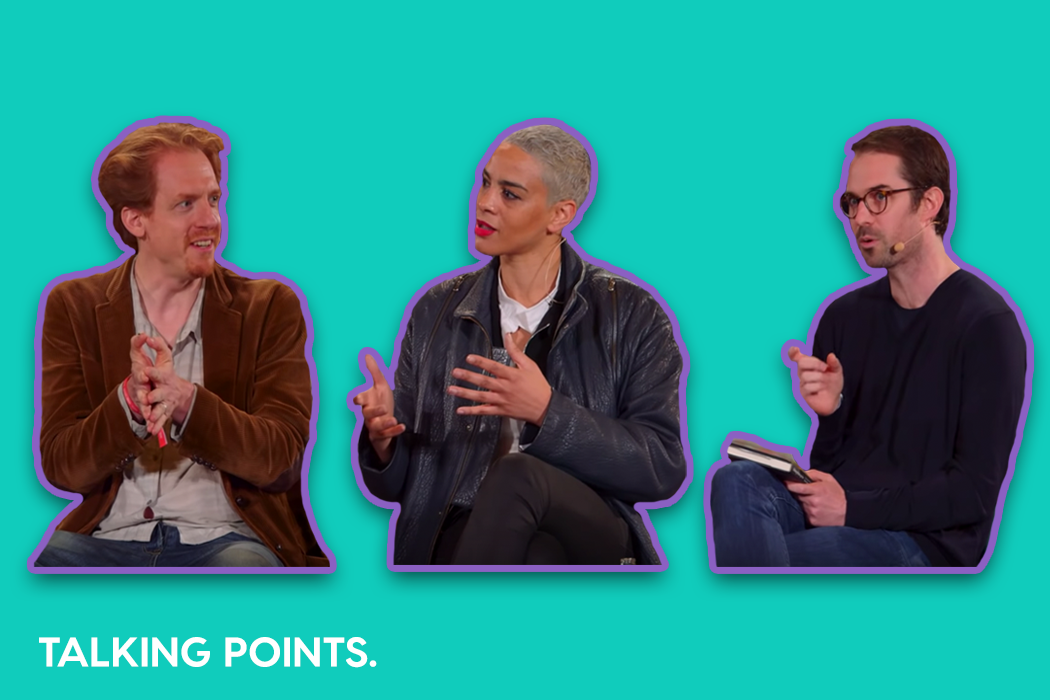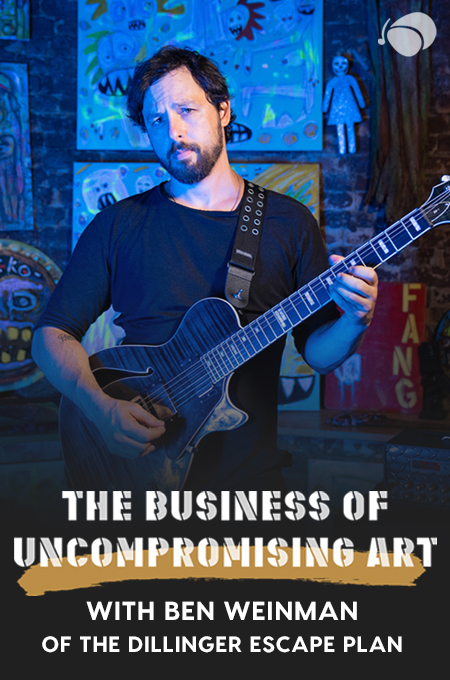
Welcome to Flypaper’s editorial column, Talking Points, where we revisit a lengthy lecture or Q&A with the greatest minds in music composition and production, and elucidate the most interesting details or concepts to gain a fresh perspective on the topic in question. In other words, we’ll pull out the talking points. Follow along with the series here if you like.
So normally with this series we look at lectures and videos that focus on a single artist, but today we’re throwing both of those concepts out the window and zooming in on a recent panel held at the annual Ableton Loop Conference featuring educators, not artists, and not one, but three of them. The panelists: Ethan Hein, Doctoral Fellow in Music Education at NYU, adjunct professor of music technology at NYU and Montclair State University, and Soundfly instructor; Melissa Uye-Parker, British songwriter, performer, and educator based in London; and Jack Schaedler, software developer at Ableton who has worked on Ableton’s microsite for learning music fundamentals. And the panel was moderated by none other than Dennis DeSantis, composer, sound designer, percussionist, and author, who is also Head of Documentation for Ableton.
The use of new technology in classrooms is a hot topic. Particularly in the field of music, tech can fundamentally reshape the whole nature of education: what it means and who it’s for. As such, controversy swirls around the use of technology in the context of music education. This discussion explores what technology brings to the classroom and what it has taken away, as well as how it has transformed student musicians from performers to composers. But it’s also quite long, so feel free to skip ahead and read on if you’d like to read our “talking points.”
1. “Eliminating the teacher could be dangerous.”
So much of today’s new technologies tend to offer (at least in marketing speak) out-of-the-box solutions to musicians’ and students’ problems. Softwares and plugins, devices and networks, are all designed to minimize the rough edges around taking the time to learn things the hard way, practice them, and interact with things and people. And while these tools are optional, and do provide new avenues for creative expression and learning, they sometimes also skip over some crucial steps in the lifelong learning process of the artist, particularly those steps that historically have happened in the classroom.
Adopting digital tools and technologies in the classroom can pose a risk for a student’s education that is tied in with social and emotional interaction and adaptation, peer-to-peer feedback (both verbal and non-verbal), and close-touch collaboration. But it can also encourage habit forming, haptics sensitivity, and muscle memory building, etc. As a somewhat heavy introduction to the lengthy conversation to follow, this topic references a lot of what’s being talked about in educational circles right now, and much of it gets fleshed out later. For now, let’s just consider that while digital tools are definitely assets in the classroom for a number of reasons, they may fall short or, at worse, cause harm to a student’s education when they approach minimizing or eliminating the teacher and their role.
2. “Even though I’m a teacher, most meaningful music education right now is happening outside of classrooms.”
Hein almost mentions this in passing, but it’s an interesting concept to keep in mind these days. Our new “teachers” may in fact be the unnamed, unseen, un-interacted-with software engineers and designers who created the DAWs (as well as the plugins inside them) that we use for almost all things musical in the 21st century. Those folks shaped how we learn about engineering and production, recording, and even composition, and learning to use their software inevitably means learning about those concepts from the lens of the software’s interface and application.
Beyond training for classical and jazz performance, it’s common now to be learning music mostly on our own. But perhaps we need to start considering how impactful the tools themselves can be on our educational path.
3. “If we’re using computers to deliver 19th century music pedagogy (as many people currently are), the results won’t be any better than delivering that material via a chalkboard.”
Now for a bit of push-back on the general tone so far. We (and the panelists in the video) have mentioned how technology can create some dangerous grey areas when it comes to education — such as removing the vital social aspects of learning and of music practice in general, and also subjecting education to frameworks often designed by non-musicians or engineers lacking a diversity of musical knowledge, awareness, and respect (and thus unable to build tools that allow for all modes of musical expression).
However, from an opposing perspective, we could also raise the following question: What’s the point of building technological tools that merely mimic what we’d otherwise be able to do manually, or at least through existing musical technology (i.e., instruments)? Instead we should be pushing the envelope and introducing tools into our learning practice that expand our potential for expression and leave preconceived boundaries behind. Or, we should be looking to change our educational curriculums to incorporate software that opens up new worlds for students to dive into.
An example of this might be using Sibelius to augment students’ learning and practice within a Western section of their curriculum, but introducing digital worksheets, sound libraries, and notational software to learn about Indonesian gamelan composition. Students may discuss what is gained and lost in comparative studies, what shadows exist in traditional software related to microtonal and quartertonal notation, how sound libraries can skew our perceptions of orchestral roles, etc.
That said, Hein makes a great point that often the debate is not about current technology versus better technology. Rather, it’s a question of using technology either to achieve a result or to achieve nothing. He says, “If you’re some freshman in music school, usually the choice is not ‘shall I have a live string quartet play this or shall I have it be fake strings in Sibelius?’ No. It’s fake strings in Sibelius or nothing. And certainly when they get out of music school it’s fake strings or nothing.” So, having technology be there to help us along doesn’t take anything away, it enables us to do more. The role of education needs to be to empower students to make the most out of what’s available and not to mistake technology’s comforts for their own creative acumen.
4. “Creating spaces for teachers to learn, and to become curious about technology.”
Turning now to the educators themselves. Technology can and should also be used to open the minds of those responsible for inspiring the minds of the next generation. We’ve come a long way in education, both as a result of advancements in technology and independent of it completely. And to recognize that our classrooms are not simply about handing over a textbook’s worth of knowledge also comes with the responsibility of adaption and providing a space for constant curiosity.
By virtue of the ways we are changing as a society, the classroom must take into account changes in epistemology, changing values and communication, and changes in how we learn and interact with the world. That starts with the teacher. We can and should meet this challenge with the same sense of “play” that we want to instil in our students. Things like educator discounts for Ableton Live and other software can help teachers to also become students, ensuring they can constantly reexamine the role of technology in the music classroom.
5. Technology as a mirror for the new rules of the classroom.
Finally, teachers are now also allowed to be artists on full display to their students.
Technology opens doors for instantaneous craftsmanship, creativity, collaboration, and interactivity, and we need to rethink our educational models to reflect those experiences. In other words, education should mirror the new normal processes that children and adults are experiencing in all other facets of life. We need to make the classroom more collaborative, more interactive, get more feet more wet and quicker. Just as we can now communicate with people via a swipe or a click, our classrooms need to enable instantaneous applications of what we learn. This will deepen student engagement with teachers as artists or practitioners.
At some point, Hein compares learning music to learning the English language. In music education you are given so so much information before you’re asked to turn it into something creative, if ever. In contrast, when you learn a language, by the second grade you’re already being asked to write stories and communicate creative ideas; it’s instant expression from the moment we begin our journey.
How can teachers, mentors, coaches, peers, colleagues, and supervisors help create environments in education where at every stage students are applying the knowledge they just learned in real time? This is precisely where technology can help.
Ready to reach your musical goals?
Our one-on-one mentorship program is built on our belief that accountability and guidance can have a huge impact on students reaching their goals and developing their musical identities. Soundfly’s community of mentors will help you set the right goals, pave the right path toward success, and stick to schedules and routines that you develop together, so you improve every step of the way.
Tell us what you’re working on, and we’ll find the right mentor or course for you!




